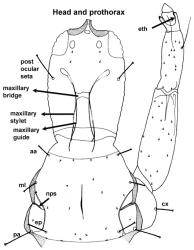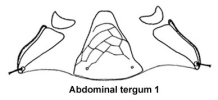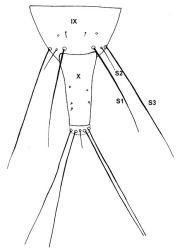 |
Scientific nameKarnyothrips melaleucus (Bagnall, 1911)
Taxonomic positionThysanoptera: Tubulifera: Phlaeothripidae
DiagnosisBody bicolored; head, thorax and abdominal segments VIII or IX-X brown; pelta and abdominak segments II-VII or VIII yellow, segments III-VII each with a small median transverse pale brown
patch near anterior margin; antennal segment I pale brown, segments II-V yellow, VI yellowish brown, VII and VIII brown; fore femora brown in basal half fading to yellow towards apex; mid and hind femora and all tibiae and tarsi yellow. Antennal segments III and IV with 1+1 and 1+1+1 sense cones respectively. Postocular setae well developed and expanded apically. All dorsal prothroacic setae (aa, ml, pa, ep) well developed, expanded apically, except anteromarginal seta which is reduced. Wings fully
developed, fore wings with 0-4 duplicated cilia. S1 setae on abdominal tergum IX pointed or blunt.
This species can be distinguished from K. flavipes by the largely yellow abdomen contrasting with the dark brown head and thorax, and the long finely acute dorsal setae on the 9th tergite (Mound & Walker, 1987). ImagesDistributionWidespread in the tropics. Denmark, Madeira, Kenya, U.S.A. (Hawaii), Trinidad, Brazil, West Malaysia, Java, Vietnam, China, India (Kerala (Calicut, Chalakudi, Palghat, Kulatupuzha); Tamil Nadu (Thimbam, Mudumalai); Karnataka (new record)).
Hosts / PreyFound usually amongst grass and leaf litter where it is presumably predatory on scale insects. It is predatory on soft scales (Pitkin, 1976).
References
|





